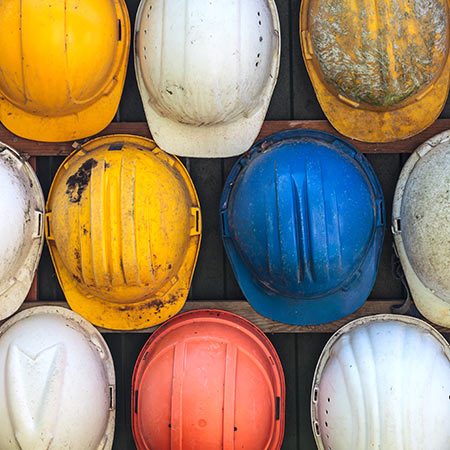
Quick receipt of Paycheck Protection Program loans may be helping contractors retain or add staff, despite mounting project cancellations. A survey that AGC conducted online April 20-23 drew 849 respondents. Of the 741 who answered a question about PPP loans, 74% reported applying for a loan: 44% had received funds, 15% had been approved but had not received funds, 8% were awaiting an answer, and 7% had applied but had been told no more funds were available. The share of respondents who reported they had added workers jumped to 13% from 4% of respondents in AGC’s April 6-9 survey, and the share that reported they had furloughed or terminated workers declined to 35% from 40%. These favorable indications occurred even though the share who reported winning additional work held steady at 18% of respondents, the share reporting that an owner had halted an ongoing project had risen from 41% of respondents to 50%, and the share reporting that an owner had canceled an upcoming project had climbed from 19% of respondents to 28%. The share reporting project delays or disruptions edged up from 65% of respondents to 67% and the share reporting suppliers had notified them that deliveries would be late or canceled rose from 42% of respondents to 49%.
The Architecture Billings Index “plummeted in March [seasonally adjusted] by 20.1 points to a score of 33.3,” the American Institute of Architects reported on Wednesday. The index measures the percentage of surveyed architecture firms that reported higher billings than a month earlier, less the percentage reporting lower billings. Any score below 50 (on a 0-100 scale) indicates a decrease in billings. “In addition, indicators of future work also declined at a staggering rate in March as uncertainty abounds. Firms also reported a sharp decline in their backlogs, from a near-record high of 6.3 months at the start of the year to an average of 5.0 months at the end of the first quarter. Billings also declined across all regions of the country and all firm specializations in March. Conditions softened the most at firms located in the Northeast, likely due in large part to the nearly complete shuttering of New York City, as well as the construction stop order in Boston. Firms with a commercial/industrial specialization also reported the softest conditions so far, with so much uncertainty over what the future holds for the hospitality and retail sectors in particular. Billings declined the least at firms with an institutional specialization as some of those firms reported actually seeing a modest uptick in work due to increased demand for healthcare facilities.” The billings and inquiries indexes date to 1995, the design contracts index to 2010. All three indexes had record lows and record one-month declines.
“Total construction starts declined 5% from February to March” at a seasonally adjusted annual rate, Dodge Data & Analytics reported on April 15. “Volatility caused by the presence or absence of large projects in healthcare and the utility/gas plant category, however, skewed the analysis. In March, nonresidential building starts fell 9% from February (seasonally adjusted), while residential building dropped 11%. Nonbuilding construction starts, however, rose 14% during the month. For the 12 months ending March 2020, total construction starts were 2% higher than they were for the same period ending March 2019. Residential building starts were 3% higher, while nonbuilding starts were up 5%....Nonresidential building starts, however, were down less than 1%....‘Considering the calamity that occurred towards the end of March as the fallout from the covid-19 (coronavirus) hit the economy, construction starts held up rather well,’ stated [Chief Economist Richard Branch]. “Construction starts in March were unlikely to be greatly impacted as projects that broke ground during the month likely had materials sourced and in-place and labor booked well ahead of the scheduled groundbreaking. That momentum and planning is difficult to reverse at the last minute. Additionally, most of the stay-at-home orders and construction moratoriums were not instituted until the last week of the month and into April. Therefore, April construction starts are likely to be a very different story with states like New York, New Jersey and Pennsylvania among others banning construction activity. April’s starts data will be the first true indication of how the crisis will impact the construction industry.’”
“CBRE Research found that 16 of the top 20 markets for under-construction [industrial] space—accounting for 70% of total under-construction inventory nationally—have workers active and on site, with most of these projects deemed ‘essential,” CBRE reported on Tuesday. “Pennsylvania’s I-78/81 Corridor, Philadelphia, Central New Jersey and Oakland are the only markets that have shut down construction sites, although in New Jersey and Pennsylvania waivers can be granted if the construction is for buildings that will distribute essential product.”
In the latest quarterly Business Conditions Survey that the National Association for Business Economics conducted April 13-16 and released today, 86% of 105 corporate economists expect that inflation-adjusted gross domestic product (real GDP) will decrease between the first quarter (Q1) of 2020 and Q1 2021, including 70% who predict a decline of 2% or more. Of the 66 respondents who reported on their firms’ capital spending on structures, 15% reported rising spending in the past three months, while 29% reported falling spending. Of the 60 respondents who reported on their firms’ expected capital spending on structures over the next three months, only 5% expect spending at their firms to rise vs. 48% who expect spending to fall.
“Insurance premiums…for new construction of apartment rentals are…rising,” the Wall Street Journal reported on Wednesday. “Fore Property Co., a development firm that has built some 25,000 apartments over the past three decades, recently saw 100% increase in its insurance for buildings under construction, according to Vice President Howard Stocking.”




